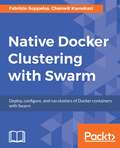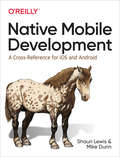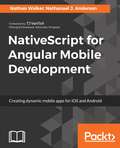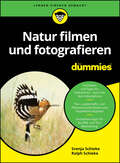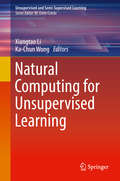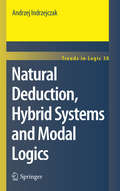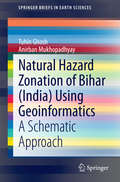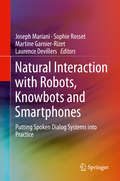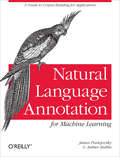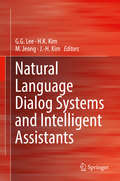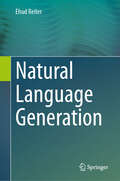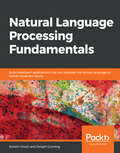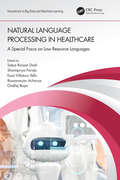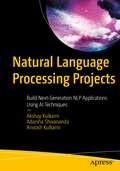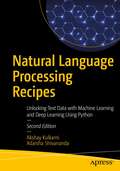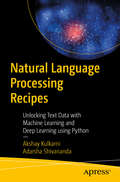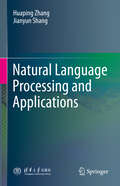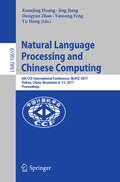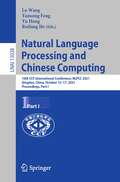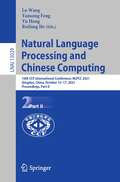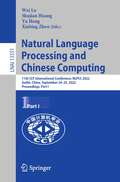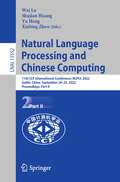- Table View
- List View
Native Docker Clustering with Swarm
by Chanwit Kaewkasi Fabrizio SoppelsaDeploy, configure, and run clusters of Docker containers with Swarm About This Book • Get to grips with Docker Swarm, one of the key components of the Docker ecosystem. • Optimize Swarm and SwarmKit features for scaling massive applications through containers. • Learn about Docker's scheduling tricks, high availability, security, and platform scalability. Who This Book Is For If you are a Linux admin or a Docker user who wants to natively manage Docker clusters, then this is the book for you. What You Will Learn • Create and manage Swarm Mode clusters of any size • Get a backstage view of the biggest Swarms ever built : Swarm2k and Swarm3k, with their 2,300 and 4,700 nodes • Discovery mechanisms and Raft • Deploy your containerized app on Swarm • Administer Swarm clusters on AWS, Azure, and DigitalOcean • Integrate Flocker volumes with Swarm • Create and manage Swarms on OpenStack Magnum In Detail Docker Swarm serves as one of the crucial components of the Docker ecosystem and offers a native solution for you to orchestrate containers. It's turning out to be one of the preferred choices for Docker clustering thanks to its recent improvements. This book covers Swarm, Swarm Mode, and SwarmKit. It gives you a guided tour on how Swarm works and how to work with Swarm. It describes how to set up local test installations and then moves to huge distributed infrastructures. You will be shown how Swarm works internally, what's new in Swarmkit, how to automate big Swarm deployments, and how to configure and operate a Swarm cluster on the public and private cloud. This book will teach you how to meet the challenge of deploying massive production-ready applications and a huge number of containers on Swarm. You'll also cover advanced topics that include volumes, scheduling, a Libnetwork deep dive, security, and platform scalability. Style and approach A comprehensive guide that covers all aspects of Docker Swarm from setup to customization.
Native Mobile Development: A Cross-Reference for iOS and Android
by Shaun Lewis Mike DunnLearn how to make mobile native app development easier. If your team frequently works with both iOS and Android—or plans to transition from one to the other—this hands-on guide shows you how to perform the most common development tasks in each platform. Want to learn how to make network connections in iOS? Or how to work with a database in Android? This book has you covered.In the book’s first part, authors Shaun Lewis and Mike Dunn from O’Reilly’s mobile engineering group provide a list of common, platform-agnostic tasks. The second part helps you create a bare-bones app in each platform, using the techniques from part one.Common file and database operationsNetwork communication with remote APIsApplication lifecycleCustom views and componentsThreading and asynchronous workUnit and integration testsConfiguring, building, and running an app on a device
NativeScript for Angular Mobile Development
by Nathanael J. Anderson Nathan WalkerLearn NativeScript to build native mobile applications with Angular, TypeScript, JavaScript About This Book • Power packed hands-on guide to help you become pro-efficient with NativeScript • Harness the power of your web development skills with JavaScript and Angular to build cross-platform mobile apps • Create highly maintainable and feature-rich apps with TypeScript and NativeScript APIs Who This Book Is For This book assumes you have a general understanding of TypeScript, have heard of NativeScript and know what it's about, and are familiar with Angular (2.0). You don't need to be an expert in any of these technologies, but having some sense of them before reading is recommended this book, which is ideal for intermediate to advanced users. What You Will Learn • Bootstrap a NativeScript for Angular app • Best practices for project organization • Style your app with CSS/SASS • Use Angular together with NativeScript to create cross-platform mobile apps • Take advantage of powerful Angular features, such as Dependency Injection, Components, Directives, Pipes, and NgModules right within your NativeScript apps •Gain insight into great project organization and best practices •Use Objective C/Swift and Java APIs directly from TypeScript •Use rich framework features and third-party plugins •Style your app with CSS/SASS •Integrate @ngrx/store + @ngrx/effects to help with state management •Test your app with Karma and Appium In Detail NativeScript is an open source framework that is built by Progress in order to build truly native mobile apps with TypeScript, JavaScript or just Angular which is an open source framework built by Google that offers declarative templates, dependency injection, and fully featured modules to build rich applications. Angular's versatile view handling architecture allows your views to be rendered as highly performant UI components native to iOS and Android mobile platforms. This decoupling of the view rendering layer in Angular combined with the power of native APIs with NativeScript have together created the powerful and exciting technology stack of NativeScript for Angular. This book focuses on the key concepts that you will need to know to build a NativeScript for Angular mobile app for iOS and Android. We'll build a fun multitrack recording studio app, touching on powerful key concepts from both technologies that you may need to know when you start building an app of your own. The structure of the book takes the reader from a void to a deployed app on both the App Store and Google Play, serving as a reference guide and valuable tips/tricks handbook. By the end of this book, you'll know majority of key concepts needed to build a successful NativeScript for Angular app. Style and approach This step-by-step advanced tutorial focuses on the key concepts you need to know to build a NativeScript for Angular mobile app for iOS and Android.
Natur filmen und fotografieren für Dummies (Für Dummies)
by Svenja Schieke Ralph SchiekeFangen Sie spannende Motive in der Natur ein – mit Ihrer Kamera Schon mit wenig Ausrüstung können Sie wunderbare Momente festhalten – nicht nur in Einzelbildern, sondern auch im Film. Wie Sie Landschaften und Tiere filmen und fotografieren, lernen Sie in diesem Buch. Svenja und Ralph Schieke zeigen Ihnen Schritt für Schritt von der Planung bis zur Veröffentlichung, wie spannende und interessante Naturfotografien und Naturfilme mit dem gewissen Etwas entstehen. Sie erfahren, wie Sie Motive finden, welche Ausrüstung Sie benötigen, was Sie bei den Aufnahmen beachten müssen und wie Sie Ihre Ergebnisse weiter bearbeiten. Sie erfahren Wie Sie auch mit Ihrem Smartphone gelungene Aufnahmen machen Warum sich die Stadt nicht verstecken muss, wenn es um Naturaufnahmen gehtWie Sie einen Film planen und in der Natur Schritt für Schritt umsetzenWo Sie Ihre Aufnahmen präsentieren können
Natural Computing for Unsupervised Learning (Unsupervised and Semi-Supervised Learning)
by Ka-Chun Wong Xiangtao LiThis book highlights recent research advances in unsupervised learning using natural computing techniques such as artificial neural networks, evolutionary algorithms, swarm intelligence, artificial immune systems, artificial life, quantum computing, DNA computing, and others. The book also includes information on the use of natural computing techniques for unsupervised learning tasks. It features several trending topics, such as big data scalability, wireless network analysis, engineering optimization, social media, and complex network analytics. It shows how these applications have triggered a number of new natural computing techniques to improve the performance of unsupervised learning methods. With this book, the readers can easily capture new advances in this area with systematic understanding of the scope in depth. Readers can rapidly explore new methods and new applications at the junction between natural computing and unsupervised learning. Includes advances on unsupervised learning using natural computing techniquesReports on topics in emerging areas such as evolutionary multi-objective unsupervised learning Features natural computing techniques such as evolutionary multi-objective algorithms and many-objective swarm intelligence algorithms
Natural Deduction, Hybrid Systems and Modal Logics
by Andrzej IndrzejczakThis book provides a detailed exposition of one of the most practical and popular methods of proving theorems in logic, called Natural Deduction. It is presented both historically and systematically. Also some combinations with other known proof methods are explored. The initial part of the book deals with Classical Logic, whereas the rest is concerned with systems for several forms of Modal Logics, one of the most important branches of modern logic, which has wide applicability.
Natural Hazard Zonation of Bihar (India) Using Geoinformatics
by Tuhin Ghosh Anirban MukhopadhyayWith increased climate variability, aggravated natural hazards in the form of extreme events are affecting the lives and livelihoods of many people. This work serves as a basis for formulating a 'preparedness plan' to ensure the effective policy formulation for planned development. Increased demand and competition with a high degree of variability have forced people to struggle in order to prosper. Good governance and innovative policy formulation are necessary to create a resilient society. This may promote a paradigm shift in the mindset on and perceptions of natural hazards and their impacts on development and growth. This new perspective will make people more concerned about minimizing the loss of life, property, and environmental damage and directly safeguard the development process. This book presents a detailed methodological approach to monitoring meteorological, hydrological, and climate change aspects to help resolve issues related to our environment, resources, and economies in the changing climate situation.
Natural Interaction with Robots, Knowbots and Smartphones
by Joseph Mariani Sophie Rosset Martine Garnier-Rizet Laurence DevillersThese proceedings presents the state-of-the-art in spoken dialog systems with applications in robotics, knowledge access and communication. It addresses specifically: 1. Dialog for interacting with smartphones; 2. Dialog for Open Domain knowledge access; 3. Dialog for robot interaction; 4. Mediated dialog (including crosslingual dialog involving Speech Translation); and,5. Dialog quality evaluation. These articles were presented at the IWSDS 2012 workshop.
Natural Language Analytics with Generative Large-Language Models: A Practical Approach with Ollama and Open-Source LLMs (SpringerBriefs in Computer Science)
by Paulo Novais Dalila Durães Francisco S. Marcondes Adelino Gala Renata Magalhães Fernando Perez de BrittoThis book explores the application of generative Large Language Models (LLMs) for extracting and analyzing data from natural language artefacts. Unlike traditional uses of LLMs, such as translation and summarization, this book focuses on utilizing these models to convert unstructured text into data that can be processed through the data science pipeline to generate actionable insights. The content is designed for professionals in diverse fields including cognitive science, linguistics, management, and information systems. It combines insights from both industry and academia to provide a comprehensive understanding of how LLMs can be effectively used for natural language analytics (NLA). The book details practical methodologies for implementing LLMs locally using open-source tools, ensuring data privacy and feasibility without the need for expensive infrastructure. Key topics include interpretant, mindset and cultural analysis, emphasizing the use of LLMs to derive soft data—qualitative information crucial for nuanced decision-making. The text also outlines the technical aspects of LLMs, including their architecture, token embeddings, and the differences between encoder-based and decoder-based models. By providing a case study and practical examples, the authors show how LLMs can be used to meet various analytical needs, making this book a valuable resource for anyone looking to integrate advanced natural language processing techniques into their data analysis workflows.
Natural Language Annotation for Machine Learning: A Guide to Corpus-Building for Applications
by James Pustejovsky Amber StubbsCreate your own natural language training corpus for machine learning. Whether you’re working with English, Chinese, or any other natural language, this hands-on book guides you through a proven annotation development cycle—the process of adding metadata to your training corpus to help ML algorithms work more efficiently. You don’t need any programming or linguistics experience to get started.Using detailed examples at every step, you’ll learn how the MATTER Annotation Development Process helps you Model, Annotate, Train, Test, Evaluate, and Revise your training corpus. You also get a complete walkthrough of a real-world annotation project.Define a clear annotation goal before collecting your dataset (corpus)Learn tools for analyzing the linguistic content of your corpusBuild a model and specification for your annotation projectExamine the different annotation formats, from basic XML to the Linguistic Annotation FrameworkCreate a gold standard corpus that can be used to train and test ML algorithmsSelect the ML algorithms that will process your annotated dataEvaluate the test results and revise your annotation taskLearn how to use lightweight software for annotating texts and adjudicating the annotationsThis book is a perfect companion to O’Reilly’s Natural Language Processing with Python.
Natural Language Dialog Systems and Intelligent Assistants
by Gary Geunbae Lee Hong Kook Kim Minwoo Jeong Ji-Hwan KimThis book covers state-of-the-art topics on the practical implementation of Spoken Dialog Systems and intelligent assistants in everyday applications. It presents scientific achievements in language processing that result in the development of successful applications and addresses general issues regarding the advances in Spoken Dialog Systems with applications in robotics, knowledge access and communication. Emphasis is placed on the following topics: speaker/language recognition, user modeling / simulation, evaluation of dialog system, multi-modality / emotion recognition from speech, speech data mining, language resource and databases, machine learning for spoken dialog systems and educational and healthcare applications.
Natural Language Generation
by Ehud ReiterIn late 2022, the prominence of Natural Language Generation (NLG) surged with the advent of advanced language models like ChatGPT. While these developments have captivated both academic and commercial sectors, the focus has predominantly been on the latest innovations, often overlooking the rich history and foundational work in NLG. This book aims to provide a comprehensive overview of NLG, encompassing not only language models but also alternative approaches, user requirements, evaluation methods, safety and testing protocols, and practical applications. Drawing on decades of NLG research, the book is designed to be a valuable resource for both researchers and developers, offering insights that remain relevant far beyond the current technological landscape. Natural Language Generation focuses on data-to-text but also looks at other types of NLG including text summarization. The book takes a holistic approach to NLG, looking at requirements (what users are looking for), design, data issues, testing, evaluation, safety and ethical issues as well as technology. The holistic approach is unique to this book and is very valuable for people building real-world NLG systems, and for academics and researchers who are interested in applied NLG. The author, who previously co-authored a seminal NLG book in 2000, emphasizes high-level concepts and methodologies, ensuring the material's longevity and utility. The book is structured to balance technical depth with practical relevance, including chapters on rule-based and neural NLG approaches, user requirements, rigorous evaluation techniques, and safety considerations. Real-world applications, particularly in journalism, business intelligence, summarization, and medicine, are explored to illustrate NLG's potential and scalability. With personal anecdotes and examples from the author's experiences, this book provides a unique and engaging perspective on the evolving field of NLG, making it an indispensable guide for those looking to harness the power of language generation technologies.
Natural Language Generation in Interactive Systems
by Amanda Stent Srinivas BangaloreAn informative and comprehensive overview of the state-of-the-art in natural language generation (NLG) for interactive systems, this guide serves to introduce graduate students and new researchers to the field of natural language processing and artificial intelligence, while inspiring them with ideas for future research. Detailing the techniques and challenges of NLG for interactive applications, it focuses on the research into systems that model collaborativity and uncertainty, are capable of being scaled incrementally, and can engage with the user effectively. A range of real-world case studies is also included. The book and the accompanying website feature a comprehensive bibliography, and refer the reader to corpora, data, software and other resources for pursuing research on natural language generation and interactive systems, including dialog systems, multimodal interfaces and assistive technologies. It is an ideal resource for students and researchers in computational linguistics, natural language processing and related fields.
Natural Language Interfaces to Databases (Synthesis Lectures on Data Management)
by Dragomir Radev Yunyao Li Davood RafieiThis book presents a comprehensive overview of Natural Language Interfaces to Databases (NLIDBs), an indispensable tool in the ever-expanding realm of data-driven exploration and decision making. After first demonstrating the importance of the field using an interactive ChatGPT session, the book explores the remarkable progress and general challenges faced with real-world deployment of NLIDBs. It goes on to provide readers with a holistic understanding of the intricate anatomy, essential components, and mechanisms underlying NLIDBs and how to build them. Key concepts in representing, querying, and processing structured data as well as approaches for optimizing user queries are established for the reader before their application in NLIDBs is explored. The book discusses text to data through early relevant work on semantic parsing and meaning representation before turning to cutting-edge advancements in how NLIDBs are empowered to comprehend and interpret human languages. Various evaluation methodologies, metrics, datasets and benchmarks that play a pivotal role in assessing the effectiveness of mapping natural language queries to formal queries in a database and the overall performance of a system are explored. The book then covers data to text, where formal representations of structured data are transformed into coherent and contextually relevant human-readable narratives. It closes with an exploration of the challenges and opportunities related to interactivity and its corresponding techniques for each dimension, such as instances of conversational NLIDBs and multi-modal NLIDBs where user input is beyond natural language. This book provides a balanced mixture of theoretical insights, practical knowledge, and real-world applications that will be an invaluable resource for researchers, practitioners, and students eager to explore the fundamental concepts of NLIDBs.
Natural Language Processing Fundamentals: Build intelligent applications that can interpret the human language to deliver impactful results
by Dwight Gunning Sy Hwang Dongjun JungNatural Language Processing Fundamentals is designed for novice and mid-level data scientists and machine learning developers, who want to gather and analyze text data to build an NLP-powered product. It'll help you to have prior experience of coding in Python - using data types, writing functions, and importing libraries. Some experience with linguistics and probability is useful but is not necessary.
Natural Language Processing In Healthcare: A Special Focus on Low Resource Languages (Innovations in Big Data and Machine Learning)
by Biswaranjan Acharya Satya Ranjan Dash Shantipriya Parida Esaú Villatoro Tello Ondřej BojarNatural Language Processing In Healthcare: A Special Focus on Low Resource Languages covers the theoretical and practical aspects as well as ethical and social implications of NLP in healthcare. It showcases the latest research and developments contributing to the rising awareness and importance of maintaining linguistic diversity. The book goes on to present current advances and scenarios based on solutions in healthcare and low resource languages and identifies the major challenges and opportunities that will impact NLP in clinical practice and health studies.
Natural Language Processing Projects: Build Next-Generation NLP Applications Using AI Techniques
by Akshay Kulkarni Adarsha Shivananda Anoosh KulkarniLeverage machine learning and deep learning techniques to build fully-fledged natural language processing (NLP) projects. Projects throughout this book grow in complexity and showcase methodologies, optimizing tips, and tricks to solve various business problems. You will use modern Python libraries and algorithms to build end-to-end NLP projects. The book starts with an overview of natural language processing (NLP) and artificial intelligence to provide a quick refresher on algorithms. Next, it covers end-to-end NLP projects beginning with traditional algorithms and projects such as customer review sentiment and emotion detection, topic modeling, and document clustering. From there, it delves into e-commerce related projects such as product categorization using the description of the product, a search engine to retrieve the relevant content, and a content-based recommendation system to enhance user experience. Moving forward, it explains how to build systems to find similar sentences using contextual embedding, summarizing huge documents using recurrent neural networks (RNN), automatic word suggestion using long short-term memory networks (LSTM), and how to build a chatbot using transfer learning. It concludes with an exploration of next-generation AI and algorithms in the research space. By the end of this book, you will have the knowledge needed to solve various business problems using NLP techniques.What You Will LearnImplement full-fledged intelligent NLP applications with PythonTranslate real-world business problem on text data with NLP techniquesLeverage machine learning and deep learning techniques to perform smart language processingGain hands-on experience implementing end-to-end search engine information retrieval, text summarization, chatbots, text generation, document clustering and product classification, and more Who This Book Is ForData scientists, machine learning engineers, and deep learning professionals looking to build natural language applications using Python
Natural Language Processing Recipes: Unlocking Text Data with Machine Learning and Deep Learning Using Python
by Akshay Kulkarni Adarsha ShivanandaFocus on implementing end-to-end projects using Python and leverage state-of-the-art algorithms. This book teaches you to efficiently use a wide range of natural language processing (NLP) packages to: implement text classification, identify parts of speech, utilize topic modeling, text summarization, sentiment analysis, information retrieval, and many more applications of NLP. The book begins with text data collection, web scraping, and the different types of data sources. It explains how to clean and pre-process text data, and offers ways to analyze data with advanced algorithms. You then explore semantic and syntactic analysis of the text. Complex NLP solutions that involve text normalization are covered along with advanced pre-processing methods, POS tagging, parsing, text summarization, sentiment analysis, word2vec, seq2seq, and much more. The book presents the fundamentals necessary for applications of machine learning and deep learning in NLP. This second edition goes over advanced techniques to convert text to features such as Glove, Elmo, Bert, etc. It also includes an understanding of how transformers work, taking sentence BERT and GPT as examples. The final chapters explain advanced industrial applications of NLP with solution implementation and leveraging the power of deep learning techniques for NLP problems. It also employs state-of-the-art advanced RNNs, such as long short-term memory, to solve complex text generation tasks. After reading this book, you will have a clear understanding of the challenges faced by different industries and you will have worked on multiple examples of implementing NLP in the real world.What You Will LearnKnow the core concepts of implementing NLP and various approaches to natural language processing (NLP), including NLP using Python libraries such as NLTK, textblob, SpaCy, Standford CoreNLP, and moreImplement text pre-processing and feature engineering in NLP, including advanced methods of feature engineeringUnderstand and implement the concepts of information retrieval, text summarization, sentiment analysis, text classification, and other advanced NLP techniques leveraging machine learning and deep learningWho This Book Is ForData scientists who want to refresh and learn various concepts of natural language processing (NLP) through coding exercises
Natural Language Processing Recipes: Unlocking Text Data with Machine Learning and Deep Learning using Python
by Akshay Kulkarni Adarsha ShivanandaImplement natural language processing applications with Python using a problem-solution approach. This book has numerous coding exercises that will help you to quickly deploy natural language processing techniques, such as text classification, parts of speech identification, topic modeling, text summarization, text generation, entity extraction, and sentiment analysis. Natural Language Processing Recipes starts by offering solutions for cleaning and preprocessing text data and ways to analyze it with advanced algorithms. You’ll see practical applications of the semantic as well as syntactic analysis of text, as well as complex natural language processing approaches that involve text normalization, advanced preprocessing, POS tagging, and sentiment analysis. You will also learn various applications of machine learning and deep learning in natural language processing.By using the recipes in this book, you will have a toolbox of solutions to apply to your own projects in the real world, making your development time quicker and more efficient. What You Will LearnApply NLP techniques using Python libraries such as NLTK, TextBlob, spaCy, Stanford CoreNLP, and many moreImplement the concepts of information retrieval, text summarization, sentiment analysis, and other advanced natural language processing techniques.Identify machine learning and deep learning techniques for natural language processing and natural language generation problemsWho This Book Is ForData scientists who want to refresh and learn various concepts of natural language processing through coding exercises.
Natural Language Processing and Applications
by Huaping Zhang Jianyun ShangThis book gives a comprehensive introduction to natural language processing (NLP) and its applications, covering the topics of multimodal data processing, Chinese word segmentation, new word discovery, named entity recognition, keyword analysis, and knowledge graph construction in terms of semantic analysis. The inaugural chapter provides an overview of NLP, and the subsequent chapters delve into the foundations of artificial intelligence, covering traditional deep learning algorithms and platforms. The book then evolves to showcase the latest advancements in deep learning, addressing bottlenecks and unfolding developments from data-oriented, training-oriented, and application-oriented perspectives. Part II of the book navigates the practical applications of intelligent language processing. From web crawlers and multi-format document parsing to speech text recognition, readers gain insights into real-world scenarios. Each chapter provides examples and analyses, empowering readers to bridge theoretical knowledge with hands-on application, unlocking the transformative potential of AI through intelligent language processing. This book serves as a comprehensive resource for researchers, graduate students, and undergraduates in the field of natural language processing. Additionally, it offers valuable insights as a reference for engineers, technicians, and enthusiasts interested in the realm of big data intelligence. The translation was done with the help of artificial intelligence. A subsequent human revision was done primarily in terms of content.
Natural Language Processing and Chinese Computing
by Dongyan Zhao Yu Hong Xuanjing Huang Yansong Feng Jing JiangThis book constitutes the refereed proceedings of the 4th CCF Conference, NLPCC 2015, held in Nanchang, China, in October 2015. The 35 revised full papers presented together with 22 short papers were carefully reviewed and selected from 238 submissions. The papers are organized in topical sections on fundamentals on language computing; applications on language computing; NLP for search technology and ads; web mining; knowledge acquisition and information extraction.
Natural Language Processing and Chinese Computing: 10th CCF International Conference, NLPCC 2021, Qingdao, China, October 13–17, 2021, Proceedings, Part I (Lecture Notes in Computer Science #13028)
by Lu Wang Yu Hong Yansong Feng Ruifang HeThis two-volume set of LNAI 13028 and LNAI 13029 constitutes the refereed proceedings of the 10th CCF Conference on Natural Language Processing and Chinese Computing, NLPCC 2021, held in Qingdao, China, in October 2021.The 66 full papers, 23 poster papers, and 27 workshop papers presented were carefully reviewed and selected from 446 submissions. They are organized in the following areas: Fundamentals of NLP; Machine Translation and Multilinguality; Machine Learning for NLP; Information Extraction and Knowledge Graph; Summarization and Generation; Question Answering; Dialogue Systems; Social Media and Sentiment Analysis; NLP Applications and Text Mining; and Multimodality and Explainability.
Natural Language Processing and Chinese Computing: 10th CCF International Conference, NLPCC 2021, Qingdao, China, October 13–17, 2021, Proceedings, Part II (Lecture Notes in Computer Science #13029)
by Lu Wang Yu Hong Yansong Feng Ruifang HeThis two-volume set of LNAI 13028 and LNAI 13029 constitutes the refereed proceedings of the 10th CCF Conference on Natural Language Processing and Chinese Computing, NLPCC 2021, held in Qingdao, China, in October 2021.The 66 full papers, 23 poster papers, and 27 workshop papers presented were carefully reviewed and selected from 446 submissions. They are organized in the following areas: Fundamentals of NLP; Machine Translation and Multilinguality; Machine Learning for NLP; Information Extraction and Knowledge Graph; Summarization and Generation; Question Answering; Dialogue Systems; Social Media and Sentiment Analysis; NLP Applications and Text Mining; and Multimodality and Explainability.
Natural Language Processing and Chinese Computing: 11th CCF International Conference, NLPCC 2022, Guilin, China, September 24–25, 2022, Proceedings, Part I (Lecture Notes in Computer Science #13551)
by Wei Lu Yu Hong Shujian Huang Xiabing ZhouThis two-volume set of LNAI 13551 and 13552 constitutes the refereed proceedings of the 11th CCF Conference on Natural Language Processing and Chinese Computing, NLPCC 2022, held in Guilin, China, in September 2022.The 62 full papers, 21 poster papers, and 27 workshop papers presented were carefully reviewed and selected from 327 submissions. They are organized in the following areas: Fundamentals of NLP; Machine Translation and Multilinguality; Machine Learning for NLP; Information Extraction and Knowledge Graph; Summarization and Generation; Question Answering; Dialogue Systems; Social Media and Sentiment Analysis; NLP Applications and Text Mining; and Multimodality and Explainability.
Natural Language Processing and Chinese Computing: 11th CCF International Conference, NLPCC 2022, Guilin, China, September 24–25, 2022, Proceedings, Part II (Lecture Notes in Computer Science #13552)
by Wei Lu Yu Hong Shujian Huang Xiabing ZhouThis two-volume set of LNAI 13551 and 13552 constitutes the refereed proceedings of the 11th CCF Conference on Natural Language Processing and Chinese Computing, NLPCC 2022, held in Guilin, China, in September 2022.The 62 full papers, 21 poster papers, and 27 workshop papers presented were carefully reviewed and selected from 327 submissions. They are organized in the following areas: Fundamentals of NLP; Machine Translation and Multilinguality; Machine Learning for NLP; Information Extraction and Knowledge Graph; Summarization and Generation; Question Answering; Dialogue Systems; Social Media and Sentiment Analysis; NLP Applications and Text Mining; and Multimodality and Explainability.
